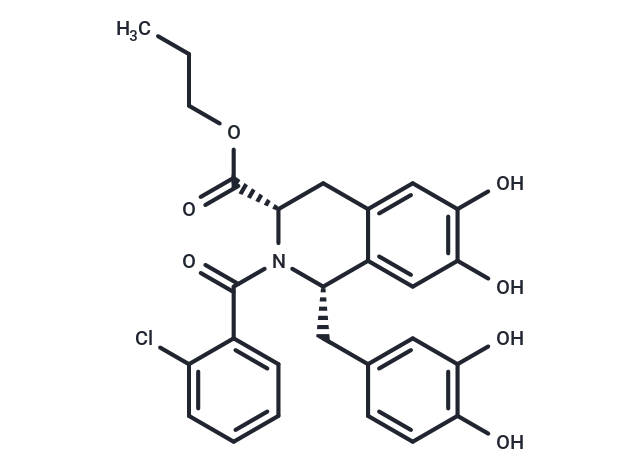Shopping Cart
Remove All Your shopping cart is currently empty
Your shopping cart is currently empty
Influenza virus-IN-6 (Compound 35) is a potent inhibitor of the N-terminal domain of the polymerase acidic protein (PA N) endonuclease subunit of the influenza virus, with an inhibitory concentration 50 (IC 50) value of 0.20 μM [1].

| Pack Size | Price | USA Warehouse | Global Warehouse | Quantity |
|---|---|---|---|---|
| 25 mg | $1,970 | 8-10 weeks | 8-10 weeks | |
| 50 mg | $2,580 | 8-10 weeks | 8-10 weeks | |
| 100 mg | $3,400 | 8-10 weeks | 8-10 weeks |
| Description | Influenza virus-IN-6 (Compound 35) is a potent inhibitor of the N-terminal domain of the polymerase acidic protein (PA N) endonuclease subunit of the influenza virus, with an inhibitory concentration 50 (IC 50) value of 0.20 μM [1]. |
| In vitro | Influenza virus-IN-6 (Compound 35) exhibits anti-influenza virus activity with EC50 values of 1.28 ± 0.35, 1.12 ± 0.65, 0.76 ± 0.11, and 0.43 ± 0.06 μM against H1N1, H5N1, H3N2, and Flu B, respectively, in MDCK cells after 48 hours [1]. At 5-20 μM for 24 hours, it affects viral replication without impacting viral particles, cellular adsorption, or release [1]. Additionally, at 2.5-10 μM for 24 hours, Influenza virus-IN-6 inhibits influenza virus polymerase activity [1]. The compound also demonstrates good stability in mouse plasma, liver microsomes, and intestinal S9-UDPGA [1]. |
| In vivo | Influenza virus-IN-6 (Compound 35) administered intraperitoneally at 7.5-30 mg/kg/d twice daily for seven days significantly protected mice against influenza virus infection [1]. In rats (n = 5), the pharmacokinetic profile of Influenza virus-IN-6 (Compound 35) after a single dose revealed the following parameters: for intravenous (IV) administration (2 mg/kg), half-life (T 1/2) was 0.33 ± 0.07 hours, peak plasma concentration (C max) was 1586.55 ± 366.48 ng/mL, area under the curve (AUC 0-t) was 536.45 ± 58.72 h·ng/mL, and clearance (CL) was 53.76 ± 13.18 mL/min/kg; for oral (PO) administration (10 mg/kg), T 1/2 was 0.82 ± 0.16 hours, time to maximum concentration (T max) was 0.52 hours, C max was 92.20 ± 36.25 ng/mL, AUC 0-t was 164.30 ± 26.37 h·ng/mL, and bioavailability (F %) was 6.13%; for intraperitoneal (IP) injection (15 mg/kg), T 1/2 was 1.07 ± 0.25 hours, T max was 0.45 hours, C max was 889.52 ± 233.17 ng/mL, AUC 0-t was 790.62 ± 188.31 h·ng/mL, and F % was 29.50% [1]. IV represents intravenous injection, IP represents intraperitoneal injection, and PO represents the gastrointestinal route. |
| Molecular Weight | 511.95 |
| Formula | C27H26ClNO7 |
| Cas No. | 2919303-26-5 |
| Smiles | CCCOC(=O)[C@@H]1CC2=CC(=C(C=C2[C@@H](N1C(=O)C3=CC=CC=C3Cl)CC4=CC(=C(C=C4)O)O)O)O |
| Storage | Powder: -20°C for 3 years | In solvent: -80°C for 1 year | Shipping with blue ice/Shipping at ambient temperature. |
| Size | Quantity | Unit Price | Amount | Operation |
|---|

Copyright © 2015-2026 TargetMol Chemicals Inc. All Rights Reserved.